|
|
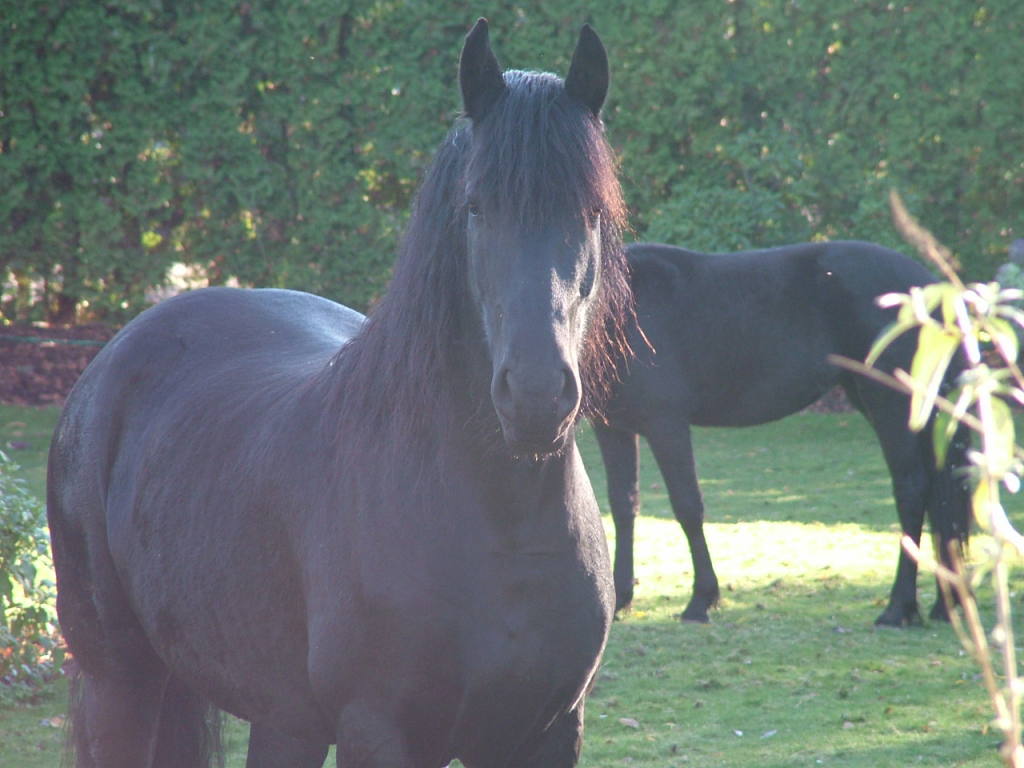 |
At the time of the pre-purchase exam, it was agreed that rather than "disturbing" this big Friesian mare with an internal exam, that a quick history from the barn manager was enough. She was maiden and had no sign or history of infection. The mare was obese (you could see the rolls of fat) and the vet advised that if. I wanted to breed her in the spring then she better loose a few pounds. We took her home and fed her appropriately. End of January we arranged for a trainer to start working with her as she was looking good. We were going on vacation for a week on February 18th and we decided to make a walkout stall and paddock for Whisper as this would be easier for those looking after the animals and she could throw her weight around if she decided to. We finished on February 06, I also dewormed her that day with Ivermectin. | |
|
On February 08 I went in the early a.m. to feed the horses and there was Whisper with her filly. At first I did not even know what it was. She was standing behind the mare and all I could see was very bent legs, I first thought it was a wet dog and when I bent to see under the mares belly, I saw that little friesian face and then I saw the short umbilical cord protruding from the mare and then literally slapped my own face. I ran for the barn phone and I called the vet. He was just as surprised. The mom and babe were both outside and it was cold. I brought her to a clean stall and recognized right away that the filly was having difficulty breathing. I thought maybe she had aspirated. Checking the mareís original stall I found the fluid was still running down the wall. I had just missed it.
|
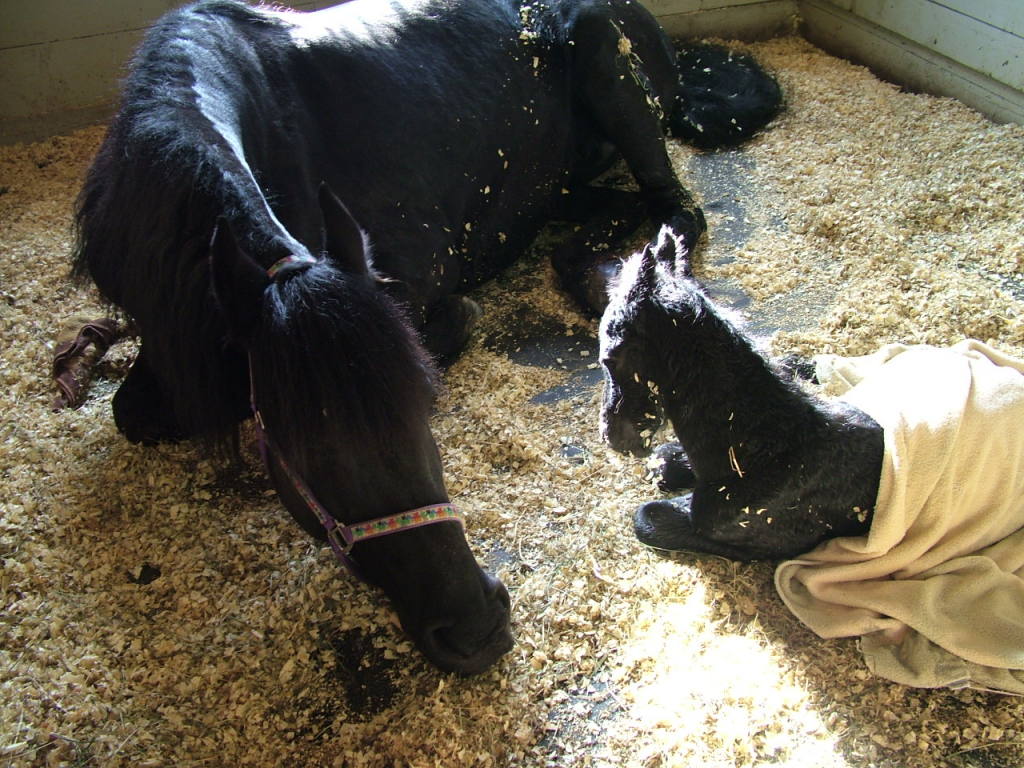 | |
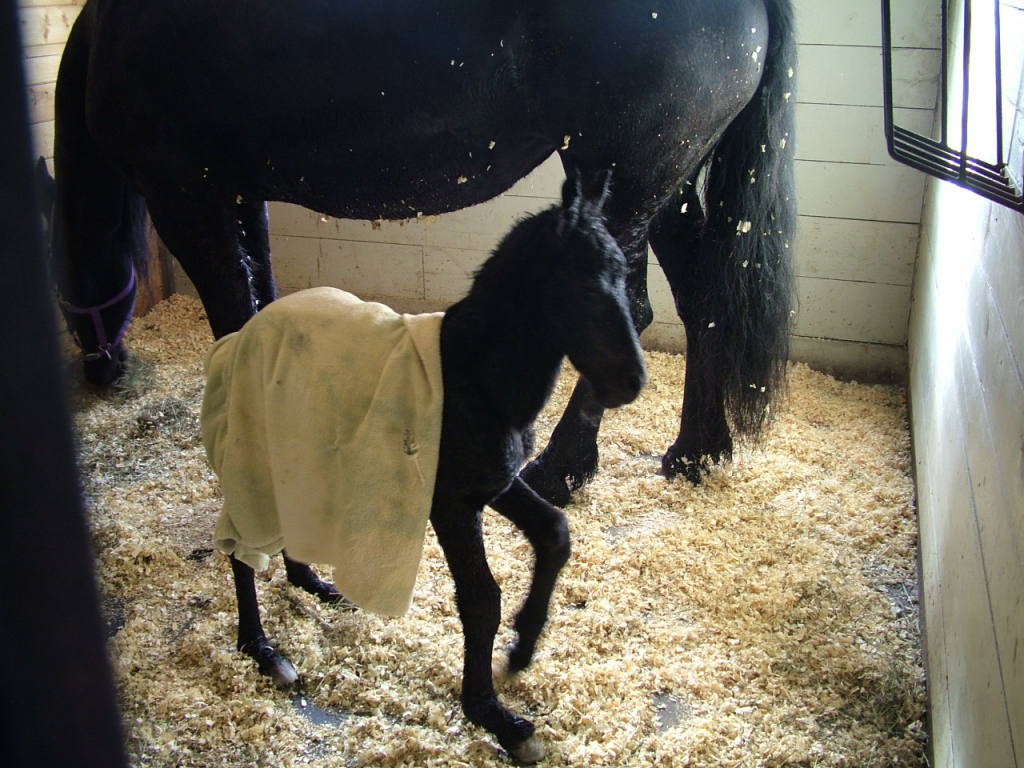 |
The vet arrived and checked both over. The placenta was in very poor condition and he had said that only 30 percent was functioning. I was feeling horrible that I had given her the Ivermectin and worried I had induced the labor. He thought that if it had, it was probably a good thing as if the filly was to go full term, the placenta was in such poor condition, she may have been born dead, while we were on holiday. He advised that the filly's lungs were not fully developed and the outcome was grave. He suggested that we put her down. I had told him that we had access to oxygen and I was willing to make the effort. He checked her further to make sure there were no brain abnormalities etc.
| |
|
All four fetlocks were on the ground and he suggested that if she survived the lung issue, that the legs would straighten on their own in a few days or even a week. She is two days old in this picture. I could see her strong spirit; she had a lot of will in her. For the first few days she could barely stand to suckle, struggle back to me, where I would sit in the corner of the stall on a big wool blanket, lie down with her head on my lap and then I put the oxygen to her nostril. She quite often would fall asleep staring up into my face, just blinking. I would just caress her and listen to music on the stereo, enjoying every minute I could. She got worse before she got better. On the second day she was not able to lay in an upright position, only down flat. Her breathing sounded rattly but not from the lungs, more like weakness in her throat, causing almost snoring sounds with gurgling. There were some very rough moments, where she would stop breathing and I would rattle her on my lap to get her to breathe. It was about the fourth day that the vet checked her lungs and found her to be functioning normally; He admitted he was very surprised. I was so glad for her (and me too as the barn floor is not cozy after four days in February) |
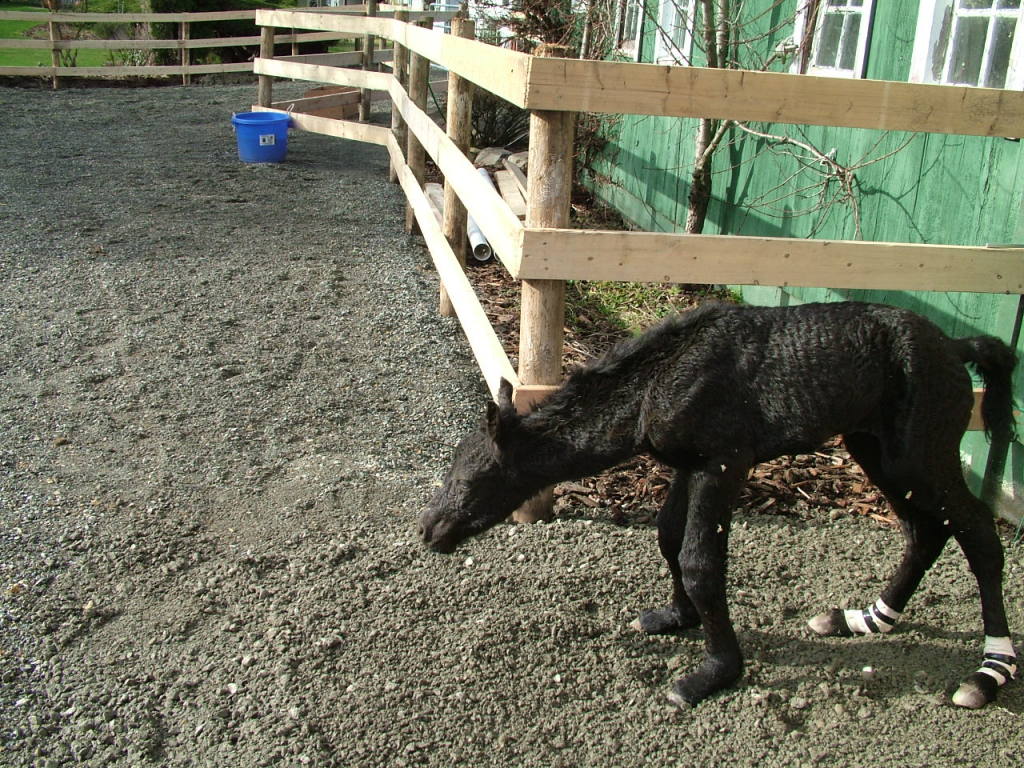 | |
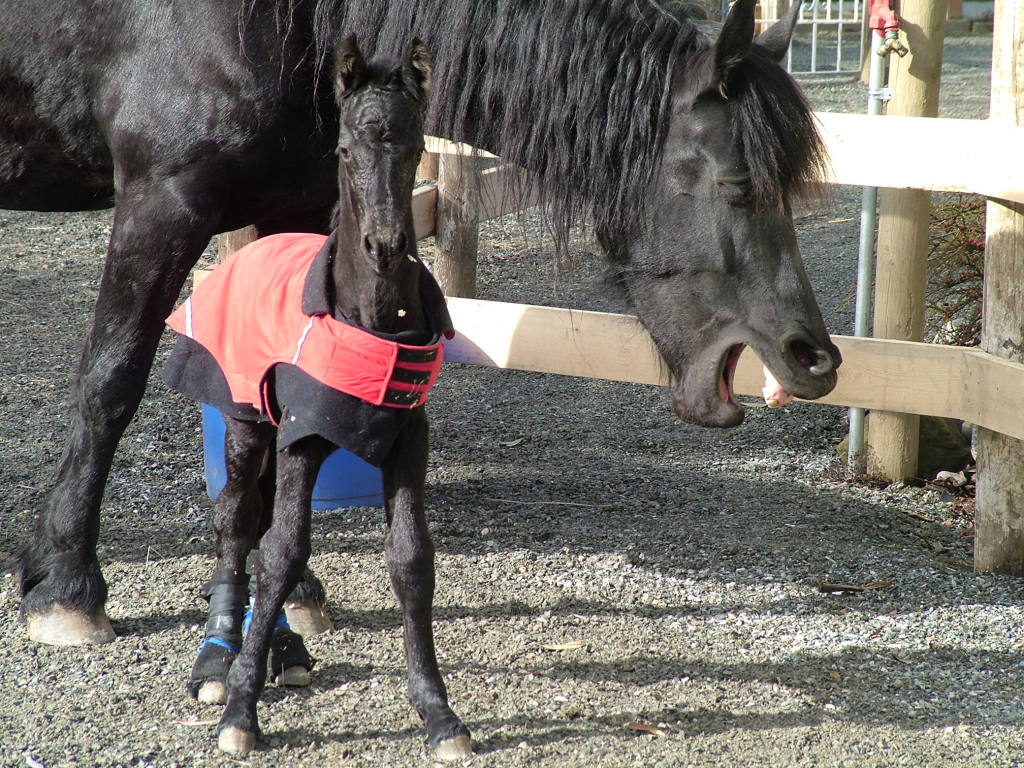 |
Her front legs straightened within a few more days but the back fetlocks were wrapped and any time she went outdoors, for protection. She would see me coming with the vet wrap and cotton and start bouncing about the stall. I wasn't sure if she was excited because she knew it meant she was about to go outside or if she was a stinker about having to hold still for the wrapping. I began to think that I would be good at calf tying. Vet, farriers, experienced breeders; all advised that she will come up on her own. I wasn't worried, she was over the worst. This picture is Tifrons wearing Cody's (my friend's dog) red coat. Poor Whisper, she was feeling it too. Just after this picture was taken, I shot a great video of Tifrons flying around the paddock. She had such a strong spirit and energy. She deliberately would show off when I was there or visitors came.
| |
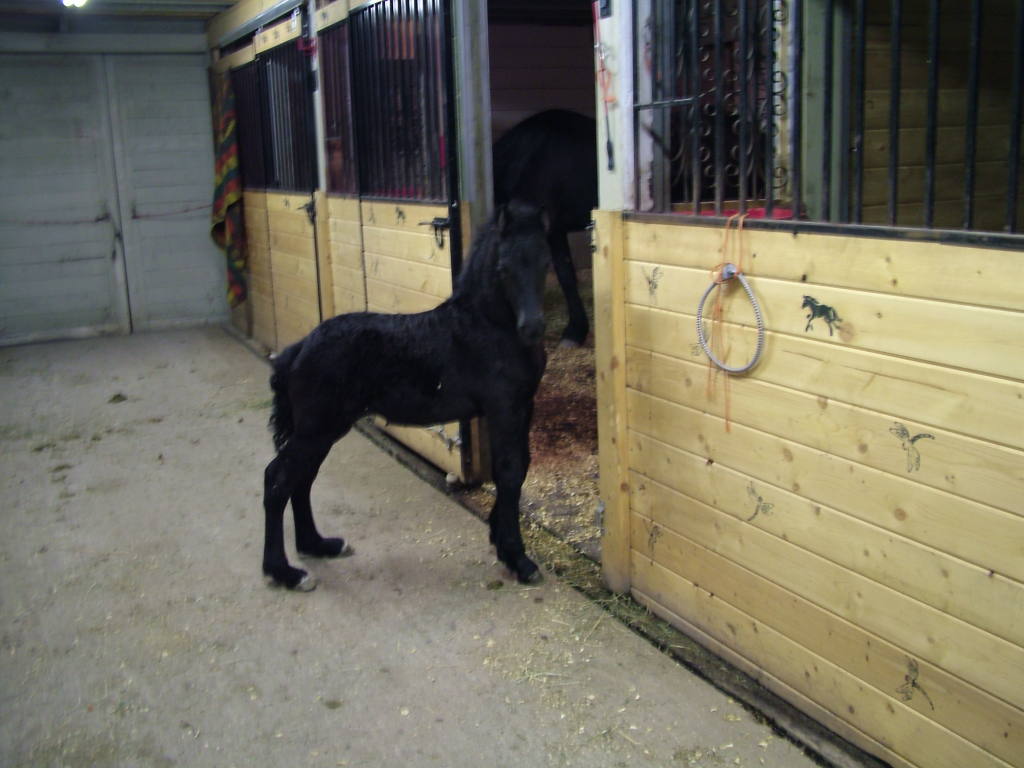 |
By four months she was more stable in her gait. She had spent a lot of time in the pasture and with that exercise there seemed to be some progress. Once her fetlock cleared the ground, it seemed to stop. The thinking was still that she would grow out of it. | |
|
At six months, she still had lots of life and her bent legs did not slow her down. She could easily keep up with her mom and was really putting on the weight. At about seven months she experience swelling in both fetlock joints. I iced them and wrapped them for support. It did not take long for them to flair up again and that was when I took her to the "specialist". She was x-rayed and a treatment plan set up. All which would be experimental. I treated her for a week with anti-inflammatory and pain medication. She was weaned as she was getting heavier, causing more stress on the back end. In this picture it is obvious that her coat was unusually long. She seemed to be slow to shed out the hair, which was very curly, almost like a sheep. I started giving her a little powdered milk in her feed and she shed the curlies out. Her new coat was still long and thick, but straight and very black. She had loads of energy and spent most of her time romping rather than eating, when out on the grass. She would chase the dog, birds and butterflies and drag and run with a branch, scaring the other horses away. Her character was very different. |
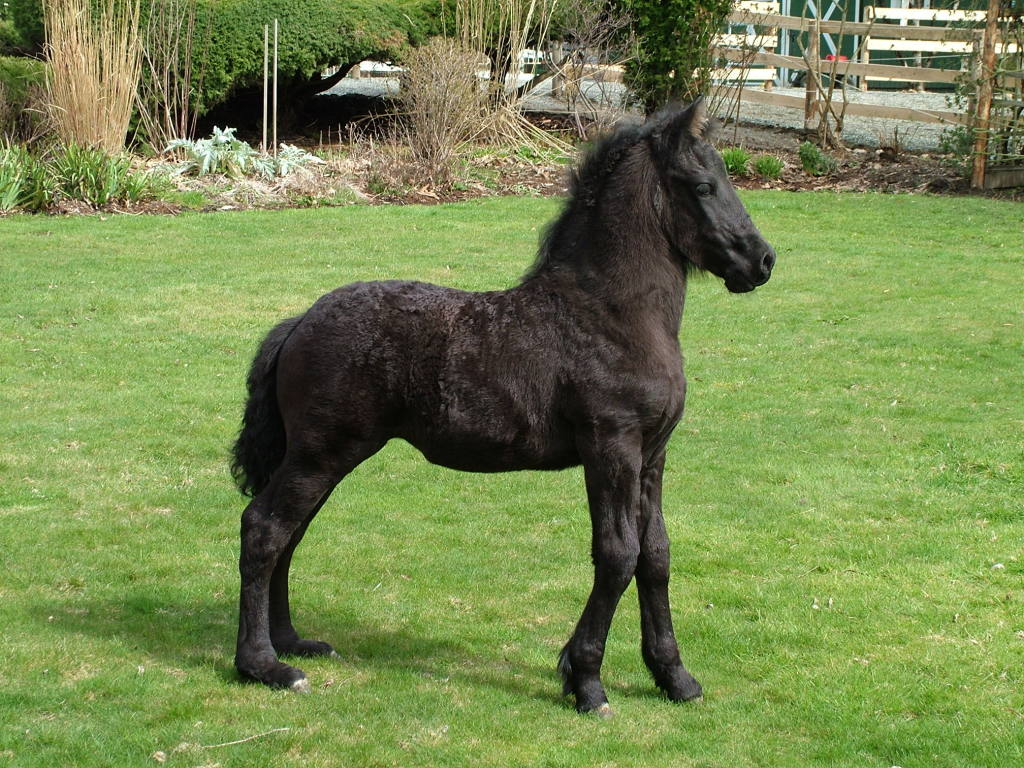 | |
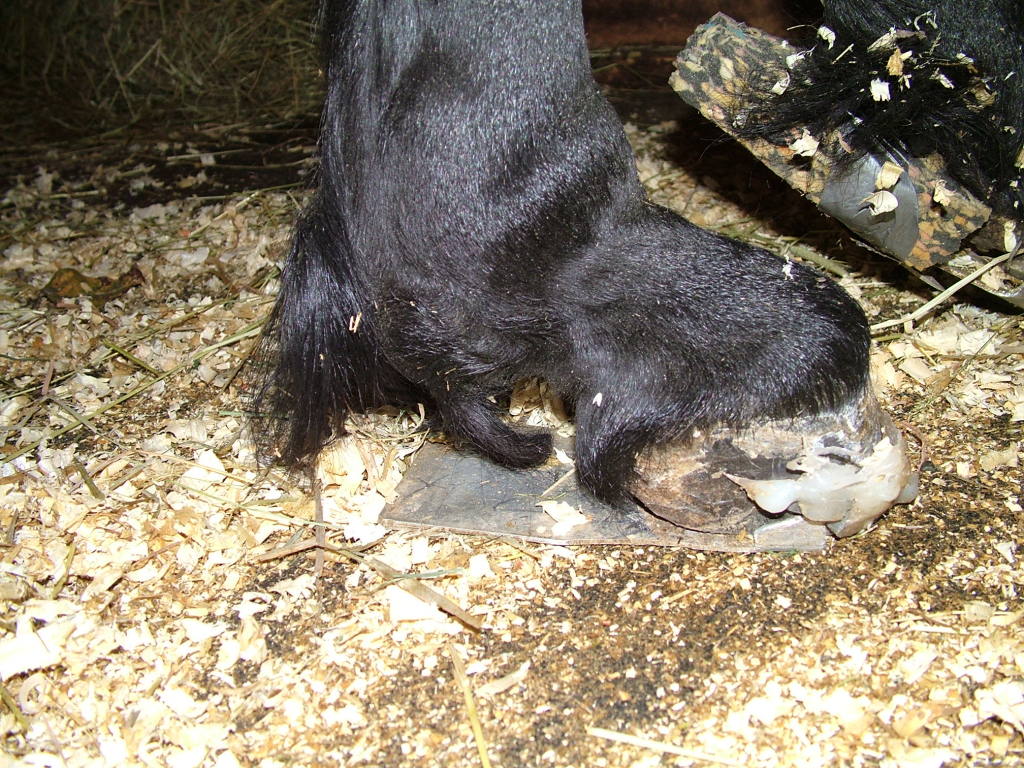 |
The diagnosis was that she had arthritis in the fetlock joint (pain and swelling). Extreme dorso-flexion of both fetlocks and contracture of the coffin joints. Digital flexor contracture and severe fetlock laxity. Initial treatment was to be glue on shoe with extended heel. I had seen this shoe on foals with leg deformities with success. In those cases the sole of the hoof was turned up and the corrective shoe would pull the toe down. Tifrons' hoof was already down, so I did not see how this was going to work for her. Once these were glued on, the extension was so long that it was obvious that she would snag them. We made large foam bracelets that fit under the fetlock for protection. I realized that this also was giving support to the fetlock and holding her up some. The glue let go after a few days, but I kept the bracelets on for support. The farrier came and re-glued the shoes on several more times and still they broke off with in a week. | |
|
Though the extended shoe did not give the result we had hoped, it did give me something to attach a heel too. After a lot of thought I gave it one more try. I used a racing shoe as it was lighter in weight. Welded a bracket to the back end and welded a toe strap, which ran across the front of the hoof. In the bracket screwed in a well padded heel. To the back of that a half piece of PVC with a wedge in it. This would force her up and forward. She had to be put to sleep for this. Once up and around, it looked great she walked with out wobble and no pain. |
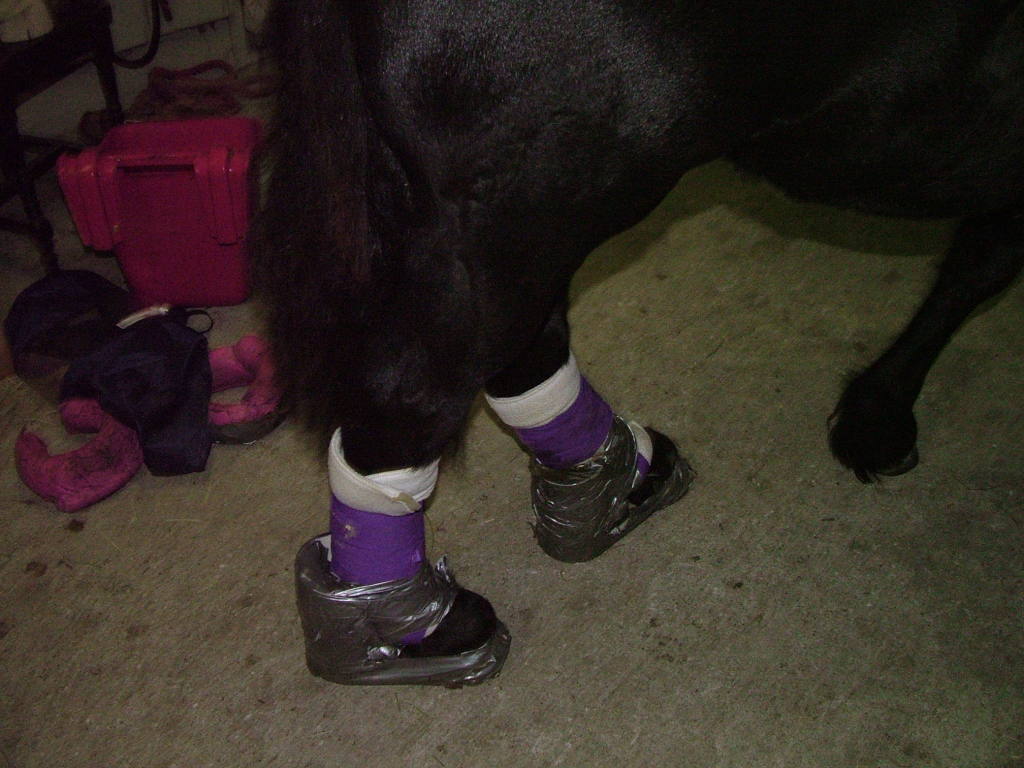 | |
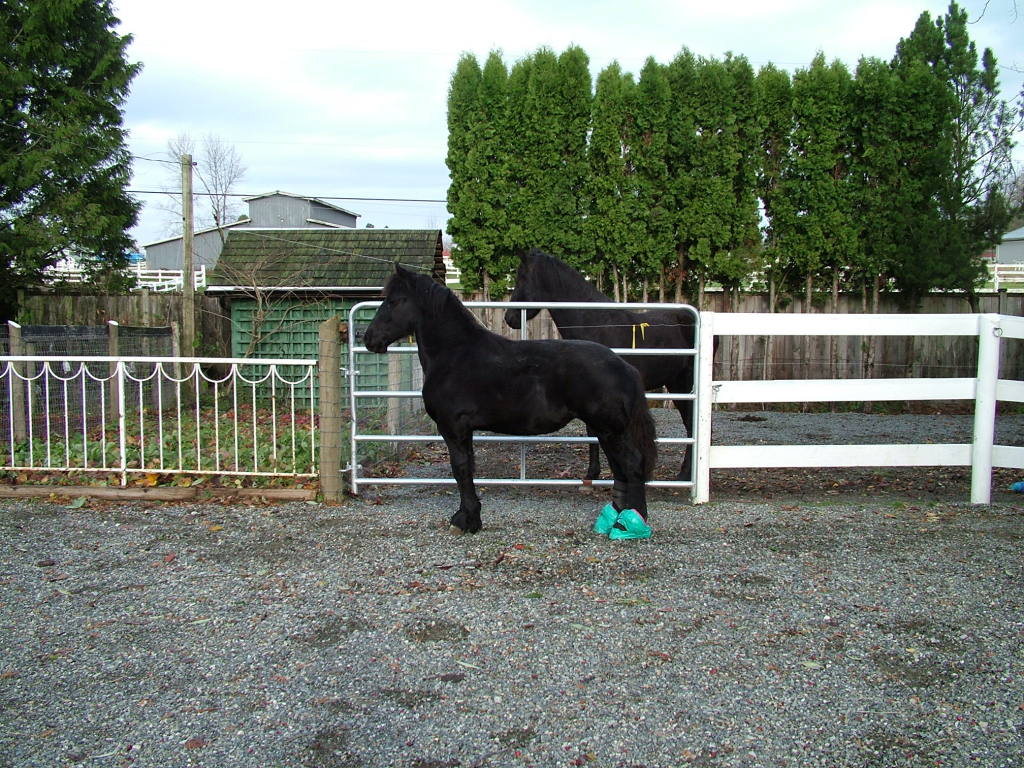 |
Unfortunately the glue did not hold more than a week. I could see that her shape was changing and was concerned about her physical structure. I massaged her daily and sometimes several times a day. I hoped it made her comfortable, keeping her muscles supple, that this would encourage straightness and give her some comfort as I figured she was experiencing some muscle aches. The bracelets were put back on and I must say that duct tape does comes in some wild colors. These bracelets offered support to free the joint of pain, but were very difficult to manage. You have to be very quick with the duct tape and it does not work well if it is cold, dirty or wet. I discovered the boil rings. This seems to be the same idea and much easier to take off and on. I do this daily as I change the under dressings to ensure that no pressure sores are forming. I believe that they also forced the contracted tendons in the coffin joints to stretch as she grew as she was looking a lot less "club footed" The vet at the time of the original diagnosis, suggested cutting the tendons and I declined. It was my thinking that she still had lots of growing to do and if those ladies in Africa can stretch there necks ten inches by adding rings, we should be able to stretch a few tendons. | |
|
Once the snow came, there was really no way to keep her wraps dry and she did get some cracks and rawness, this cleared up with antibacterial, antifungal wash and ointment with in a few days. We are fortunate, in that we have met a farrier who has had success with a mare that accidentally cut her tendons. He attached a special shoe to that mare and with the constant monitoring by himself and the owner, was able to save the horse and she now lives comfortably. He has attached a similar shoe on our filly and she is looking good. His manufactured shoe has a short extension and a lift on the rear end, shaped like a "T". The top end of the "T" is well padded and it is at a level that provides support and some upward pressure. Once the shoe was glued in place, a toe extension was created with a hardening adhesive and once dried, thin nails were used to help support the attachment. The theory is that as she grows to this position, he will adjust the angle and provide a higher support. I remove and replace the wraps several times a day to protect from pressure sores. |
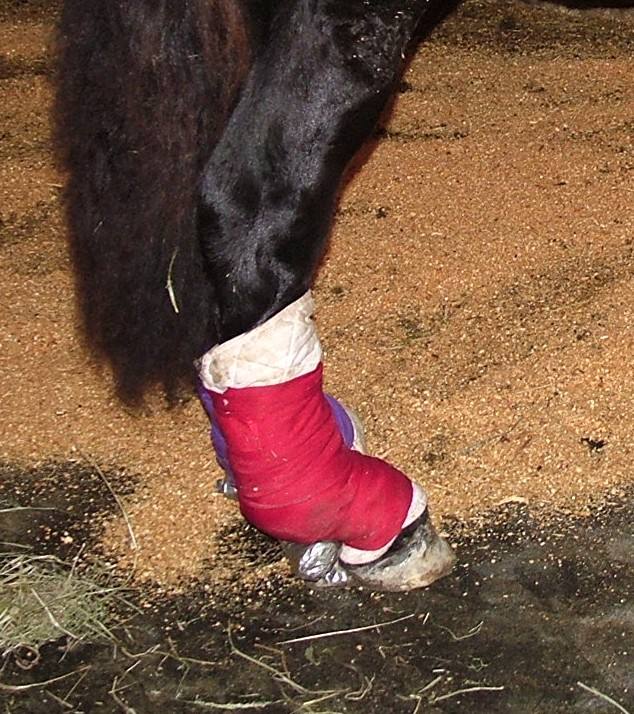 | |
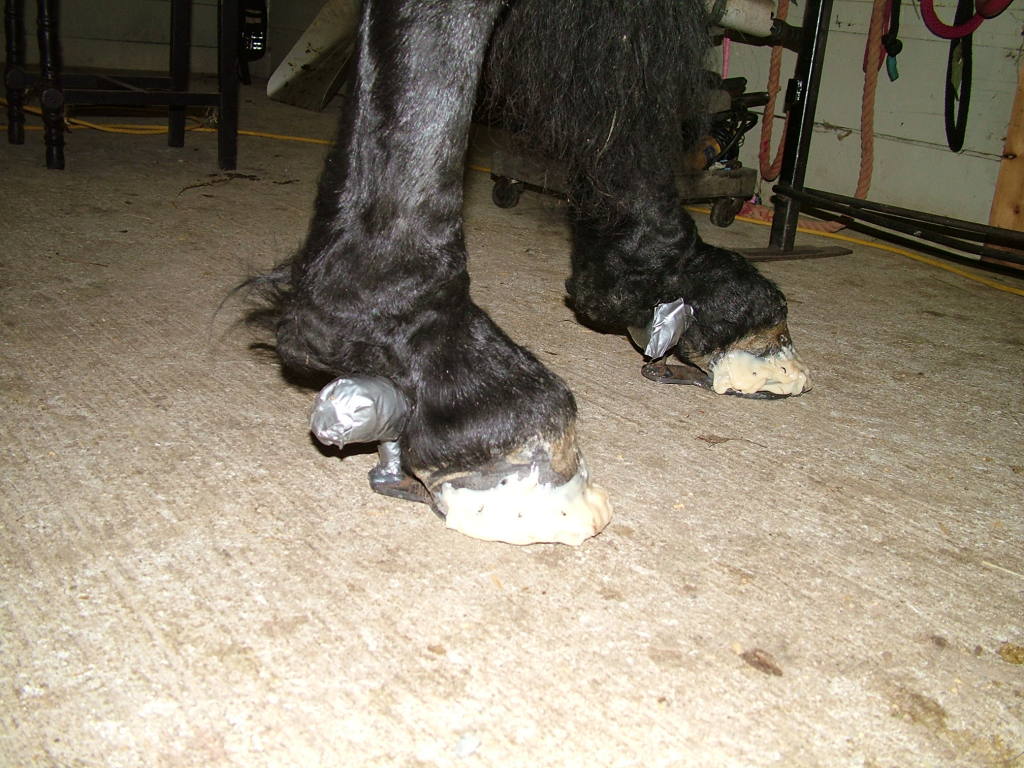 |
Here is a picture of the special "T" heel. It is wrapped with a gel pad and duct tape. I gave her some pain medication on the second day as I would imagine
she would have some muscle stiffness. This is her third day and she shows no sign of discomfort, in fact she is full of energy and attitude. As of now, we
are very hopeful as she is looking and feeling better. She is coming into a growth period and we hope the support will help with straightening her up. | |
|
Tifrons had her new shoes attached in December and by the end of January it was decided that she was coming up very nicely and a second higher pair would be made. Her mind was good and she was happy to get out and run in the snow. I gave her plenty of massages as I imagined her muscles might be sore. I checked several times a day for any signs of friction and we had no problems. I kept the bar padded with pieces of foam that would be used to insulate plumbing pipe. This was checked regularly for tears. I would wrap her fetlocks when I took her for long walks for extra protection. We would walk around the property up and down little hills to help build muscle tone. This picture is of her romping in the snow and if you go to "youtube.com" search "Tifrons" you will see a short video of her playful spirit. |
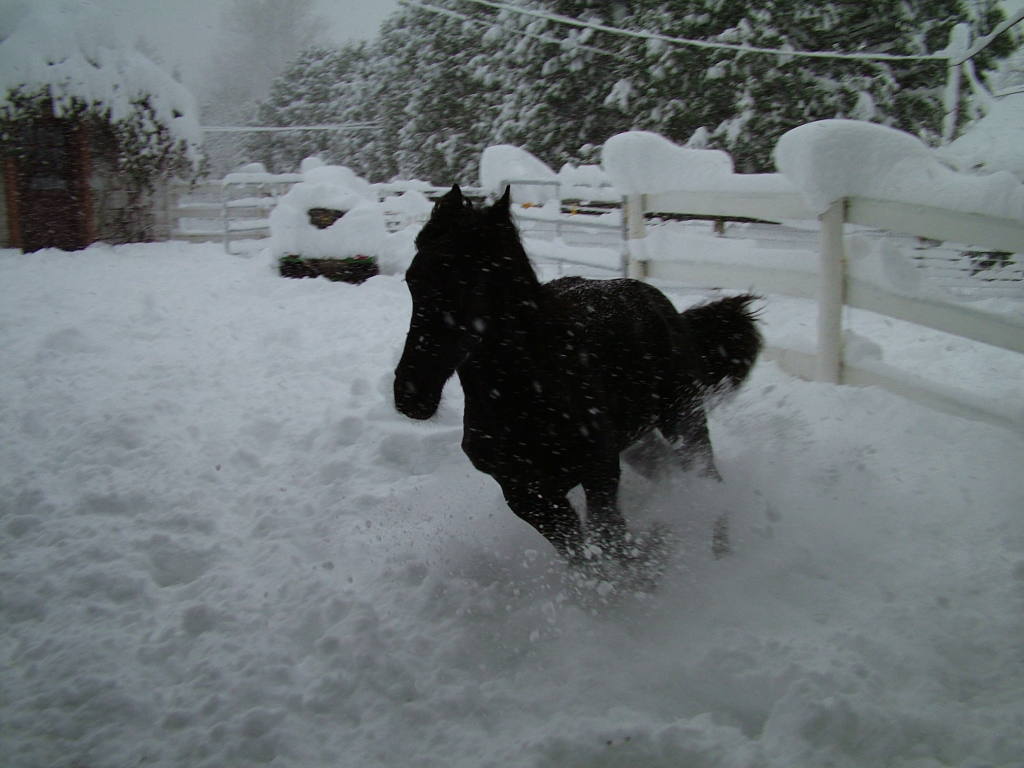 |
|
I began thinking I may not be massaging enough in the right place or was I using the heat and cold in the right place? Thatís when I had thought that some chiropractic advice may help to keep her growing straight as with this growth spurt she was going through a lot of changes. I sought the advise of a a massage therapist and a chiropractor. They came to visit Tifrons. By the second treatment, I was already second guessing my decision. It was during one of the chiro treatments that Tifrons was hurt. The manipulation of one hip was too much. She had been acting all feisty and the second he did the maneuver she dropped her head, ears went back, started to roll back and the hind leg vibrating. He had said her hip was out. I checked on her often the rest of that day and she was still having difficulty so I gave her pain meds and massage. I massaged several times a day and used lots of blue lotion for warmth. |

|
|
This was very slow to improve. When I opened the stall to let her play in the alley she came out slowly and stiff. I contacted the therapist and expressed my concern; I did not like to keep giving the medication as it had its risks too. She had recommended that I give Tifrons some herbal treatments. The therapist made a concoction of what looked like a variety of leaves that I was to soak like tea and then give to Tifrons. It contained natural anti-inflammatory, something for pain and something to protect the stomach. I found that it made her a poop a little runny and let her (the therapist) know. She did not express any concern. My farm vet was due the next day to give vaccinations to several horses, including Tifrons and I thought I would ask him about Tifrons.
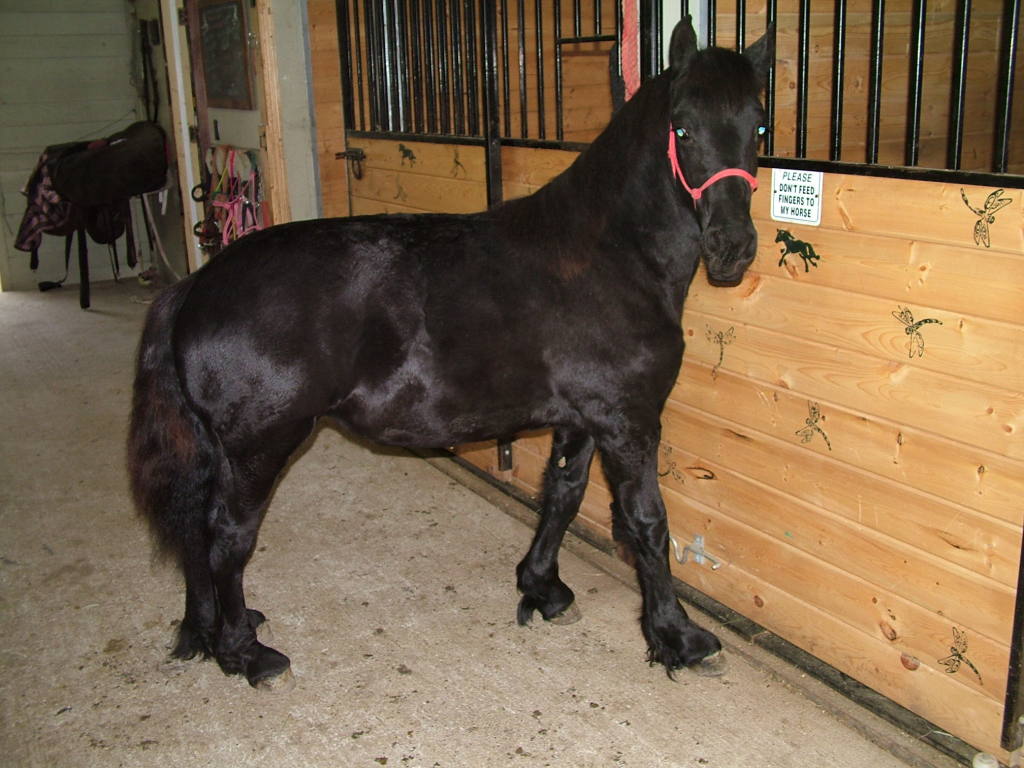
On the day the vet came to the barn, I went to halter Tifrons and thought that she was not her usual cheeky self. When I walked her outside, I could see that she was not right and looked slightly bloated. The vet arrived just as I was to take her temperature. He said she had no fever and did not believe her to be sick. I explained the situation with the hip and he asked about pain meds (I told him what I knew) he suggested I keep massaging and give it more time. He gave her the vaccination and put her back in the stall. I noticed that she laid down right away and not poking her nose through the bars to watch what was going on, as she usually did. He finished with the other horses and left, and I took her back out. She did not want to have an apple so I new her tummy was upset. I walked her for close to an hour and she had lots of gas. I kept a close eye on her food and water consumption from then on. I wondered if she was still in the stall too much and decided to put her out with her mom every day for several hours for more exercise and stimulation. She seemed to be eating and drinking normally. Rhonda, a good friend to me and the horses, recommended her vet several times as my current one seemed to be uninterested. Dr. Mario and his wife came and visited with Tifrons for several hours in the freezing cold barn. Evaluating her from top to bottom and got to know her big heart and special spirit. He was very honest and said he did not know what the answers were, but assured me that what I was doing was the right things for her EXCEPT the chiropractic work. He explained that the muscles in her back end are not as strong as a normal filly, because she was on stall rest most of the time. It was his belief that because of her atrophied muscles she did not have the structure to have these manipulations done, without causing damage. I told him of her gas colic the previous week and said I'd thought her stool was plentiful but now that I stopped the "tea" a little dry. He suggested during this visit that she "looks somewhat like a dwarf" Of course I looked it up on the internet and found nothing to confirm it.
|
|
|
Dr. Mario visited our barn two days later and told me that Tifrons has made a spot in his heart and the he had experience with electro-acupuncture and was not sure if it would work but really wanted to try. He said he wanted to help her and would not charge me, even though he would have to come three times a week for treatments. I wasn't sure. I told him that I felt guilty that I had gone with the chiropractic treatments and that she was hurt. He explained how the treatment worked and I decided to go with it. He was to start in March.
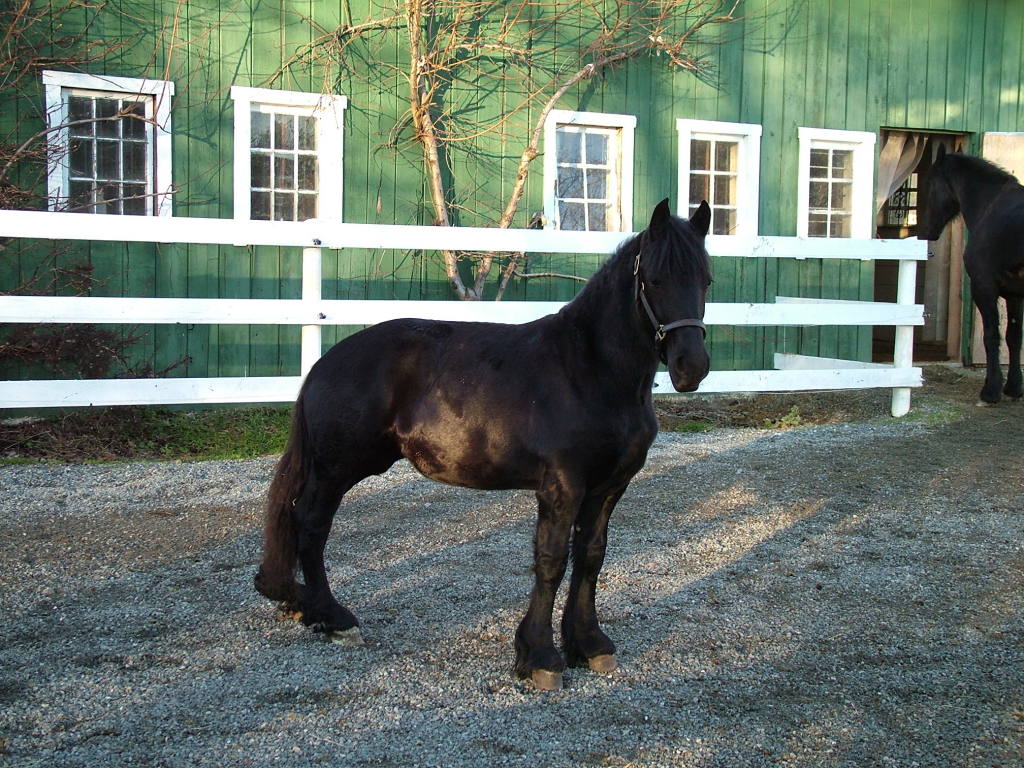 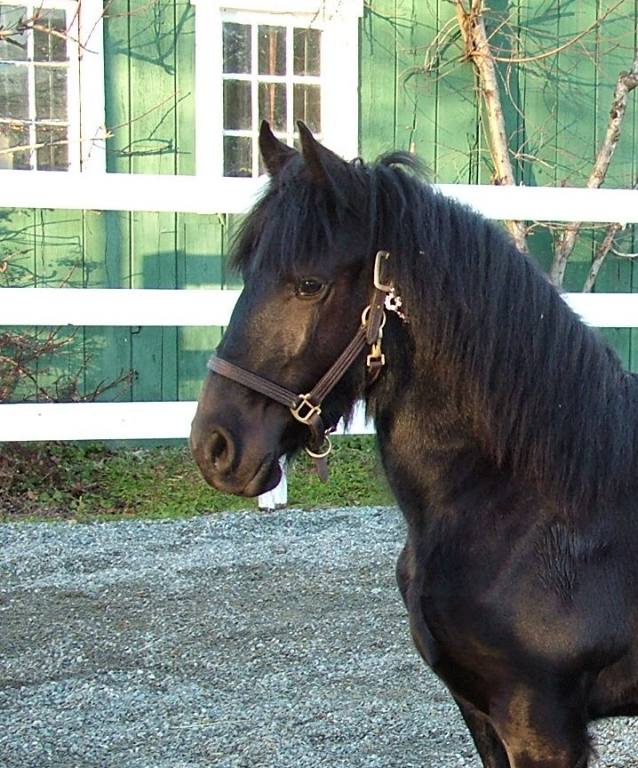
|
|
|
February 8, was her first birthday. We took lots of walks around the yard and she was bright eyed and frisky. I thought a lot that day of what the previous year was all about for the both of us. She and I were very close because we had spent so much time together. Even as I cleaned the barn she would be in the alley way, bugging the other horses through the stall bars or making sure if there was any halter, ropes, brooms, shovels, phones, coffees anything that was hanging up was knocked to the floor. She would even grab the broom by the bristles and drag it about the alley like she was helping. When she would finish eating and I would let her out right away and if I were late, she would be waiting at the stall door like a race horse at the starting gate and once the door was open she would give me a shoulder check and charge out of the barn tossing her head and striking the ground, chasing off the cat and dog and sassing any horse that was around. She kept me in my place and let me know when I was slipping.
On February 9, our morning visit went fine; I put on her rain coat and put her in the stall/ walk out, with her mom. She ran about being cheeky. By noon, I could here her mom calling. I was in the house and she usually would call if she heard me come out, as she always thought I was coming to feed her. But from in the house I could hear her call and call and call. I figured she was really wanting me for something so my daughter and I headed to the barn.
Inside the stall, Tifrons had been cast against the wall. When we flipped her over, we saw that she was covered in diarrhea. I removed her rain sheet, put on her halter and headed outside. I could see she was bloated again. I walked her a while and then she fell and rolled violently, I couldn't stop her and finally tugged her enough to stand her up.
Rhonda came right away and we gave Tifrons Banamine then she seemed to settle. I stayed in the stall with her as she was lying down, but several hours later she started rolling again. Another dose of Bananmine and I called Dr. Claire (the vet on call). She arrived quickly and after examining Tifrons, determined there was a blockage, either impaction or twist. She hydrated and administered mineral oil in hopes to get things moving.
Dr. Claire was very honest and explained everything that was going on insides Tifrons' little body. I was so thankful that Rhonda had stayed as she had seen horses colic before and also confirmed the minute by minute management and expectations. Tifrons' pain was difficult to manage. Dr. Claire gave her injections to relieve pain and Tifrons would walk and rest but then again fall to the ground, all the time her tummy bloating larger.
We spent the night walking her between pain spells, it was determined that nothing was moving and the gas build up was so severe, Tifrons intestine would eventually burst. We decided that we would not allow any more suffering and took her to see her mom. The mare is big enough to look over the dividing walls in the barn and had kept looking into Tifrons' stall to see her baby struggling and us cuddling her. I led Tifrons to the front of her moms stall so that she could be close. The mare made those low sounds she made at the birth, bonding.
I played a song that Tifrons and I had cuddled to many times "The dance" by Garth Brooks. It was on one of my barn CD's and previously when it played it made me really feel close with her and appreciate who she was to me. I wrapped her in the same wool blanket that she and I would sit on while giving her oxygen. She lay quietly with all of us, I caressed her face and told her she was my beauty, loving her and telling her how special she was, and very peacefully she was put to sleep, just as the sun broke at dawn.
Thank you to Dr. Claire and good friend Rhonda for staying with us, crying with us, in the freezing barn, all night long.
The days had been cold and wet, but this day was clear, cloudless and warm.
I knew that she could find her way to the green grasses of heaven. She can run straight and strong remembering me as I remember her, with love.
Tifrons's necropsy: |
|
|
I received the necropsy results for Tifrons and Dr. Claire called to explain things in English. The cause of death was colic and unfortunately even if we afforded the surgery, it was a type that could not even be corrected. The section of bowel that Dr. Claire had been "searching for" during her internal exam and could not find was located behind the sternum. There was no sign of parasites or larvae. What caused the colic was unknown, though it was reported that a small section of bowel appeared irritated, but Dr. Claire suggested it could have been caused after the colic progressed.
I found great comfort and disappointment when it was reported on the necropsy that dissection of the rear legs, showed no damage to circulation, nerves etc. It stated that she suffered from lax tendons. I felt good that we had not caused her more damage with our efforts but instead was sure to be corrected had we only had the chance to continue working with her.
I am very thankful to everyone who has responded to the story of Tifrons' short life.
I new that bringing this experience to the open was important to help others as I could not find help for us.
I have been recently contacted by a person in the Netherlands who is part of a team working on identifying the dwarf gene in friesians. In her small way, Tifrons is still teaching us.
I am happy to see that Fhana has publish an article on the topic of dwarfism.
|
|
|
|
| She waits at Rainbow Bridge |
|
Just this side of heaven is a place called Rainbow Bridge
When an animal dies that has been especially close to someone here, that pet goes to Rainbow Bridge. There are meadows and hills for all of our special friends so they can run and play together.
| |
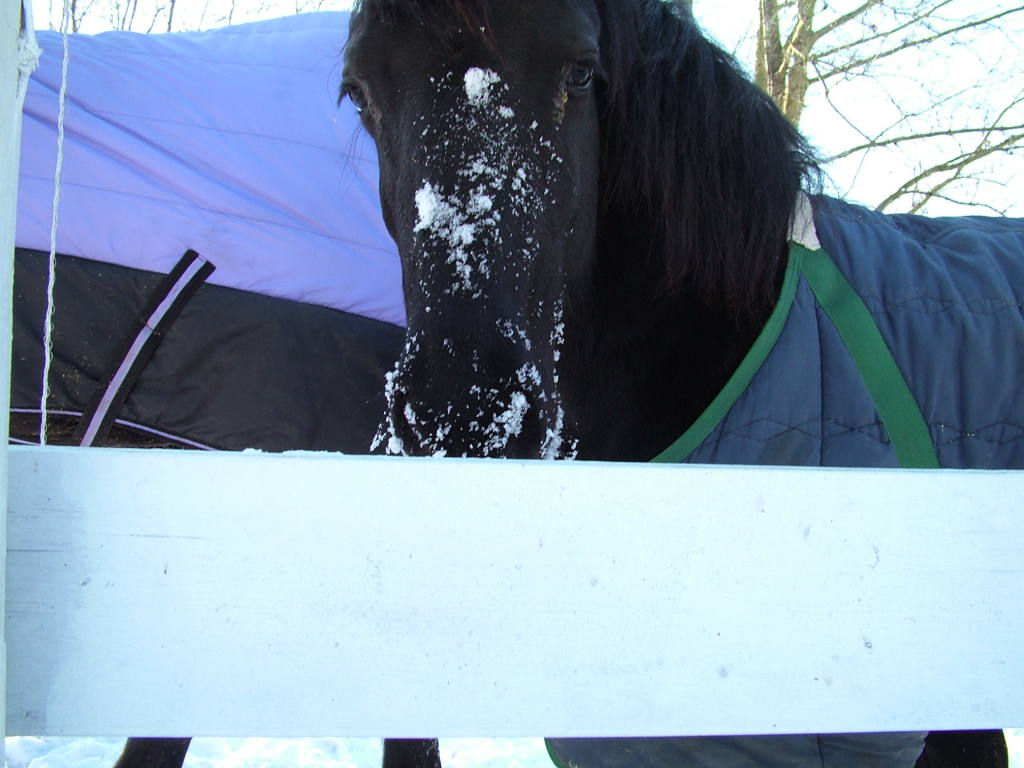 |
There is plenty of food, water and sunshine and our friends are warm and comfortable.
All of the animals who had been ill and old are restored to health and vigor.
Those who were hurt or maimed are made whole and strong again, just as we remember them in our dreams of days and times gone by. | |
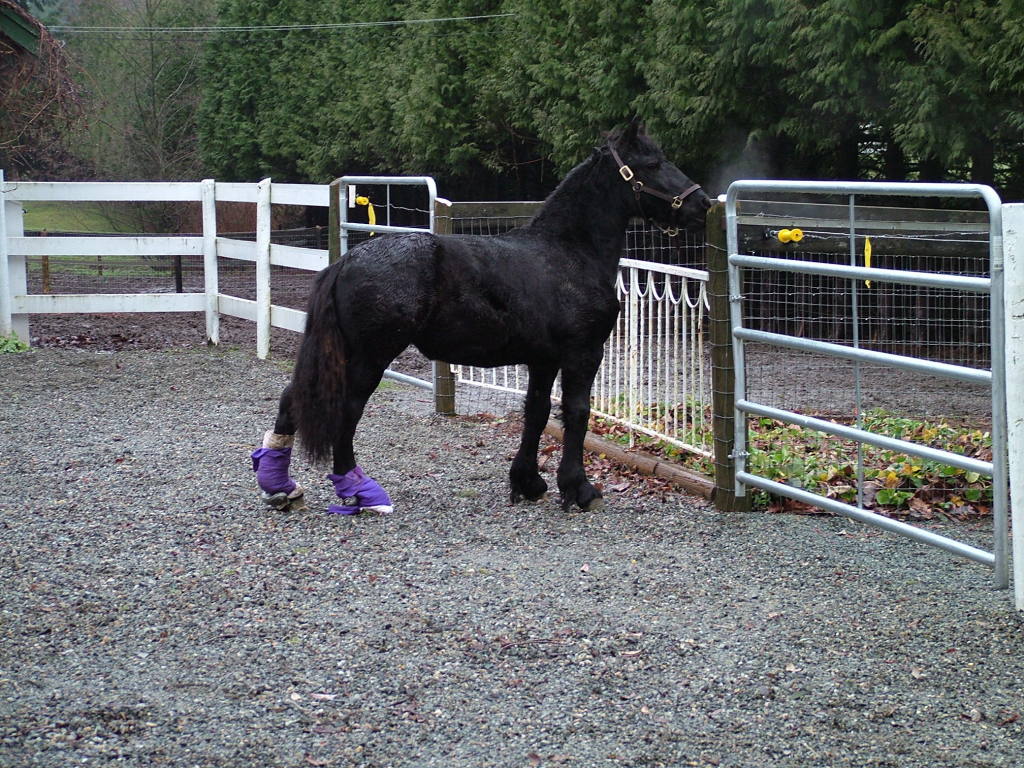 |
The animals are happy and content, except for one small thing; they each miss someone very special to them, who had to be left behind.They all run and play together, but the day comes when one suddely stops and looks into the distance. Her bright eyes are intent. Her eager body quivers. Suddenly she begins to run from the group, flying over the green grass, her legs carrying her faster and faster,
| |
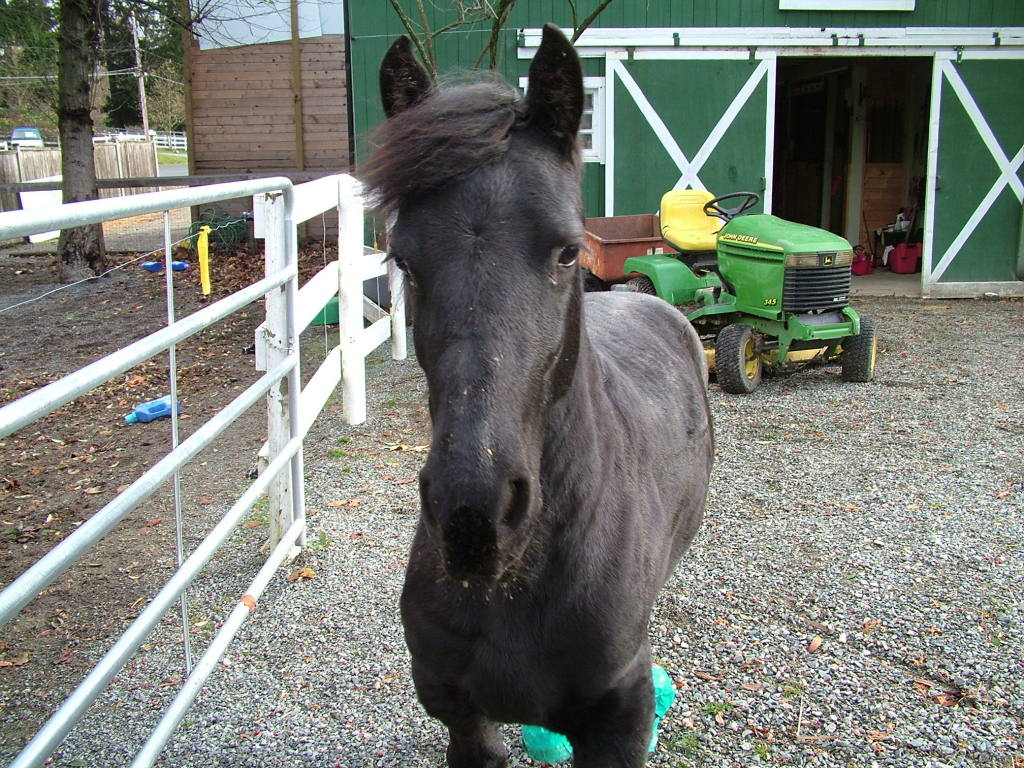 |
You have been spotted, and when you and your special friend finally meet, you cling together in joyous reunion, never to be parted again. The happy kisses rain upon your face; your hands again caress the beloved head, and you look once more into the trusting eyes of your pet, so long gone from your life but never absent from your heart.
Then you cross Rainbow Bridge together.
Author unknown
| | |
|
|
|
|
|
 |
|
 |
| |
